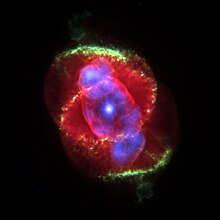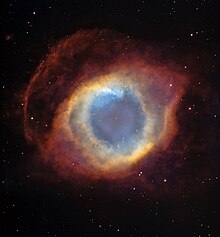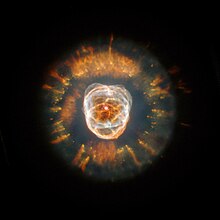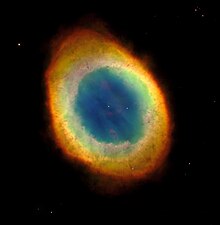行星状星云


行星状星云是恒星演化至老年的红巨星末期,气体壳层向外膨胀并被电离,形成扩大中的发射星云,经常以英文的缩写“PN”或复数的“PNe”来表示[2]。“行星状星云”这个名称源自1780年代的天文学家威廉·赫歇尔,但并不是个适当的名字,只因为当他通过望远镜观察时,这些天体呈现类似于行星的圆盘状,但又是雾濛濛的云气。因此,他结合“行星”与“星云”,创造了这个新名词。赫歇尔的命名虽然不适当,但仍被普遍的采用,并未被替换[3][4]。相较于恒星长达数十亿年岁月的一生,行星状星云只能存在数万年,只是很短暂的现象[5]。
大多数行星状星云形成的机制被认为是这样:在恒星结束生命的末期,也就是红巨星的阶段,恒星外层的气体壳被强劲的恒星风吹送进太空。红巨星在大部分的气体被驱散后,来自高温的行星状星云核心(PNN,planetary nebula nucleus)辐射的紫外线会将被驱散的恒星外层气体电离[2]。吸收紫外线的高能气体壳层围绕着中央的恒星发出朦胧的萤光,使其成为一个色彩鲜艳的行星状星云。
行星状星云在银河系演化的化学上扮演关键性的角色,将恒星创造的元素扩散成为银河系星际物质中的元素。在遥远的星系内也观察到行星状星云,收集它们的资讯有助于了解化学元素的丰度。
近年来,哈勃空间望远镜的影像显示许多行星状星云有着极其复杂和各种各样的形状。大约只有五分之一呈现球形,而且其中大多数都不是球对称。产生各种各样形状的功能和机制仍都不十分清楚,但是中央的联星、恒星风和磁场都可能发挥作用。
观测
[编辑]
图像来源:NASA、ESA、和C.R. O'Dell(范德堡大学)

图像来源:NASA、 ESA、Andrew Fruchter(STScI)、和ERO的团队(STScI + ST-ECF)。
第一个被发现的行星状星云是在狐狸座的哑铃星云。它是梅西耶在1764年发现的,并且收录为他的星表中的第27个天体:M27[6]。对只有低分辨率望远镜的早期观测者,M27和后来发现的行星状星云看起来就像巨行星中的天王星。发现天王星的威廉·赫歇尔创造了“行星状星云”这个名词来称呼他们[6][7]。起初,赫协尔认为这种天体是被可以冷凝成行星的物质包围着的恒星,而不是现在所知,有证据显示是死亡的恒星烧掉在轨道上的任何行星[8]。
直到19世纪中叶,第一次观察到行星状星云的光谱之前,我们对它的性质毫无所知。威廉·哈金斯是最早使用棱镜分解光线,使用光谱研究天体的天文学家之一[7]。在1864年8月29日,哈金斯成为第一位分解行星状星云猫眼星云光谱的天文学家[6]。他观察的恒星显示它们的光谱是有着许多暗线叠加的连续光谱。稍后,他发现许多星云状的天体,例如仙女座星云(当时的认知),都有着十分相似的光谱。这些星云后来都被证实是现在被称为星系的恒星集团。
然而,当哈金斯看到猫眼星云的光谱时,他发现这是非常不同的光谱。猫眼星云和其它类似的天体只有几条光谱线,取代叠加了吸收线的连续光谱[7]。最亮的谱线波长是500.7奈米,但与已知的任何化学元素都不相符[9]。起初,他假设这条谱线是来自一种未知的元素,并命名为nebulium。在1868年对太阳谱线的相似想法,导致氦元素的发现[6]。
虽然在太阳光谱中发现的氦,很快地就在地球上被独立发现,但nebulium始终未被发现。在20世纪初期,亨利·诺利斯·罗素提出500.7奈米谱线不是新元素发出来的,只是熟悉的元素在我们不熟悉的环境下发射出来的[6]。
在20世纪的20年代,物理学家显示在极端低密度的环境,电子可以在原子和离子中占据亚稳态的能阶维持激发态;但在高密度下,会因为撞击很快地退激发,回到基态[10]。氮和氧离子的电子在这些能阶间的跃迁(O+,O2+,也就是OIII,和N+)都能发射出500.7奈米和其他波长的谱线[6]。这些只能在低密度下看见的谱线,被称为 禁线 。光谱的观测因而证明行星状星云是极端稀薄的气体组成[11]。

行星状星云的中心恒星都非常热[2]。只有当一颗恒星几乎耗尽其核心的燃料时,它会坍缩成如此小的尺度。行星状星云被认知为恒星演化的最后阶段,而光谱的观测显示所有的行星状星云都在膨胀中。这导致行星状星云是一颗恒星在生命结束前,将它外层的气体抛进太空中所形成的想法[6]。
在20世纪后期,技术的改进,有助于对行星状星云进一步的研究[13]。空间天文台让天文学家可以研究被大气层遮蔽在外的电磁波与光波。使用红外线和紫外线研究行星状星云,可以更准确地测量行星状星云的温度、密度和元素丰度[14][15]。电荷耦合元件技术让科学家能观察到过去不可能察觉到的暗弱谱线,并比以前更准确地测量。哈勃空间望远镜也显示许多过去用地基望远镜观测只有简单和规则结构的行星状星云,在地球大气层之上的高光学分辨率下显示了极为复杂的结构[16][17]。
在摩根·凯纳光谱分类下,行星状星云被列为P型,然而在实际中很少使用此种标示法[18]。
起源
[编辑]
大于8倍太阳质量(M⊙)的恒星会以超新星结束其生命,而质量介于0.08 M⊙至8.0 M⊙的中与低质量恒星只会以行星状星云结束其生命[19]。形成行星状星云的祖恒星,在其一生的绝大部分时间都耗费在核心以大约1,500万K的温度将氢融合成氦。这种在核心进行的核聚变反应产生向外的压力,平衡了恒星引力向内要压碎裂恒星的压力[20]。也就是说,所有中低质量的恒星在主序带上的时间,都持续了数千万年至数十亿年。
当核心的氢来源减少时,重力会压缩核心,导致温度上升至大约1亿K[21]。如此高的核心温度会使恒星外围温度较低的气体壳层膨胀,创造出非常巨大的红巨星。这个最后的阶段虽然会使表面的温度下降,但是因为恒星表面积的增加,反而造成恒星的亮度急遽地上升。在恒星演化的期间,正在经历这种光度增加的恒星,就是所谓的渐近巨星分支星(AGB)[21]。
若祖恒星的质量超过3M⊙,这些质量较大的恒星形成的渐近巨星分支星,它们的核心会继续缩小。当温度达到大约1亿k,氦核会继续融合生成碳和氧,使得恒星会继续向外辐射能量,而暂时停止核心的收缩。新的氦燃烧阶段(氦原子核聚变)会在核心产生不断增长的碳和氧的核心,在它们的外面被薄薄的氦燃烧壳层包围着,再往外还有氢燃烧层。然而,这新的阶段最多只能持续20,000年左右,相较于恒星整个生命期只是很短的一段时间。
无论是何种情节,向外发散的气体是有增无减的进入太空,而当曝露的核心表面温度达到或超过30,000K时,它会辐射出足够多的紫外线光子使被抛出的大气层电离,导致气体发光成为一颗行星状星云[21]。
寿命
[编辑]
经过渐近巨星分支(AGB)阶段之后,恒星演化开始短暂的行星状星云阶段[13],气体会以每秒数公里的速度被中央恒星吹离。中央恒星是前身为在AGB的阶段失去了大部分质量的氢外壳之后,留下的电子简并碳-氧核心残骸[13]。当气体膨胀时,中央的恒星会经历两阶段的演变。首先,它因为核心的继续收缩以及核心周围的氢壳层继续进行核聚变反应使温度持续升高。然后,当氢壳的融合耗尽燃料和经由质量的损失,温度会缓慢的降低[13]。在第二个阶段,当中央恒星的质量不足以维持氦融合成碳-氧所需要的温度时,核聚变会终止,使得能量不再往外辐射[6][13]。在第一阶段,中央恒星保持恒定的光度[13],同时它变得更热,最终表面的温度可以达到约100,000K。在第二阶段,它持续的冷却,以致不足以产生足够的紫外线辐射,让日渐远离的气体继续因被电离而发光。这颗恒星演化成为白矮星,而膨胀的气体变成我们看不见的云气,结束了行星状星云的阶段[13]。对一个典型的行星状星云而言,从它的形成到再回复成为恒星的期间[6]大约是10,000年[13]。
使星系富集的角色
[编辑]行星状星云在星系演化中可能扮演着非常重要的角色。新诞生的恒星几乎完全是由氢和氦组成[23]。但是,随着恒星经历渐近巨星分支的阶段[24],它们通过核聚变创造的重元素会被强劲的恒星风驱散[25]。行星状星云通常拥有较大比率的重元素,例如碳、氮和氧,这些都会经由强大的恒星风回归至星际物质中。换言之,行星状星云大大的丰富了银河系和星云的重元素 -天文学家将比氦重的元素通通称为金属,并以金属丰度参数Z表示[26]。
从这些残骸的云气中诞生的下一代恒星,也倾向有较高丰度的重元素。虽然这些重元素在恒星中的含量都是相对的少数,但它们标记了核聚变反应对恒星演化的影响。在宇宙早期形成的恒星,在理论上只有非常微量的重元素[27],著名的例子就是贫金属的第二星族恒星(参见星族)[28][29]。恒星的金属丰度可以由光谱学来确认。
性质
[编辑]物理性质
[编辑]
影像来源:STScI/AURA

一个典型行星状星云的直径大约是1光年,并且气体极端的稀薄,密度一般从每cm3100颗到10,000颗的颗粒[30](相较之下,地球大气层每cm3包含2.5×1019颗。)。最年轻的行星状星云有着最高的密度,有时可以高达每cm3106颗。随着星云年龄的增长,它们的膨胀会造成密度降低。行星状星云的质量范围从0.1至1.0太阳质量[30]。
来自中心恒星的辐射可以将气体加热至大约10,000K[31]。中心区域的温度通常远远高于周边,可以达到16,000-25,000K[32]。邻近中心恒星附近的区域通常充满非常热的气体(星冕),温度大约1,000,000K。这些气体的来源是在中心恒星表面形成的高速恒星风[33]。
星云的边界可以用物质边界或辐射边界来界定。前者的状况:星云没有足够的物质吸收来自中央恒星辐射的所有紫外线光子,并且星云可见的部分完全被电离。后者的情况:来自中心恒星辐射出的紫外线光子,不足以使周围所有的气体电离,向外传播的电离区前缘进入包围在外面中性原子的星周包层[34]。
数量和分布
[编辑]在银河系约2,000亿颗恒星中,目前已知的行星状星云大约是3,000颗[35]。它们是如此的稀少,只因为相较于恒星的一生只占有很短的时期。它们大多是在接近银河平面的附近被发现,而且在靠近银心处最为密集[36]。
型态
[编辑]行星状星云的种类繁多,有许多不同的形状,与一些非常复杂的形式,大约只有20%是球对称(例如,参见阿贝尔39)[37]。不同的作者对行星状星云会有不同的分类:恒星、盘、环、不规则、螺旋、双极、四极[38],和其它的类型[39];然而,其中大多数只属于下列三种类型:球形、椭圆和双极性。双极星云都集中在银河平面,很可能其祖恒星是相对年轻的大质量恒星;在核球的双极星云倾向于喜欢将其轨道轴平行于银河平面[40]。在另一方面,球形的星云可能是由像太阳这样的恒星,在老年时形成的[33]。
星云有着各种各样的形状,绝大部分是投影的效果 -以不同的角度观看同一个星云,会呈现不同的形状。然而,绝大多数的物理原因尚不完全清楚[39]。如果中央的恒星是联星,与伴星之间的引力交互作用可能是原因之一。另一种可能性是当星云形成时,行星扰乱了物质离开恒星的物质流。已经确认质量越大的恒星,产生的星云越不规则[41]。在2005年1月,天文学家宣布在两个行星状星云的中心恒星检测到磁场,并且假设这些磁场要为全部或部分的形状负责[42][43]。
星团中的成员
[编辑]
目前已经在银河的四个球状星团:M15、M22、NGC 6441、帕罗马6内检出行星状星云的成员。证据也指出在M31的球状星团中也潜在著未发现的行星状星云[44]。然而,目前只有一个在疏散星团中发现行星状星云的例子,而且是不同的研究人员各自独立确认的[45][46][47]。这个案例的行星状星云是疏散星团安德鲁斯琳赛1的PHR 1315-6555。事实上,经由星团的成员估计出PHR 1315 6555最精确的距离(也就是距离上的误差只有4%)。在M46的NGC 2818和NGC 2348的案例中,行星状星云和星团的速度不能匹配,显示它们只是在视线方向上的巧合[36][48][49]。潜在的可能有PN的星团还有阿贝尔8与比卡6[50][51],和He 2-86与NGC 4463[52]。
理论模型预测行星状星云是由1-8太阳质量的主序星演化后形成的,这提升了祖恒星的年龄必须大于4,000万年以上。虽然,有几百个已知的疏散星团年龄合于这个范围,但有各种原因限制找到任何一个行星状星云的机会[36]。其中一个原因是,大质量恒星的行星状星云阶段大约只有几千年,这在宇宙的时间中只是一眨眼之间。另外,部分原因是它们的总质量太小,使得疏散集团的凝聚力较差,倾向于在相对较短的时间就溃散,通常是从1亿至6亿年之间[53]。
行星状星云研究的当前问题
[编辑]

行星状星云的距离通常很难测量[55]。距离较近的行星状星云,可以经由测量其膨胀速度,来测量出它的距离。采取相隔数年的高解析观测,可以显示星云在垂直视线方向上的扩展,而观测光谱的多普勒频移可以得知在视线方向上的速度。比较膨胀的角度和扩张的速度,就可以揭露到星云的距离[16]。
问题是如何产生种类繁多且形状各异的行星状星云,这还是个有争议性的话题。理论上,以不同速度离开恒星的物质,彼此之间的交互作用是可以产生观测到的各种形状[39]。然而,有些天文学家假设外观更复杂、更极端的行星状星云应该是靠近的联星造成的[56]。有几个呈现出强大的磁场[57],它们和电离气体的交互作用可以解释一些行星状星云的形状[43]。
测量星云中的金属丰度有两种主要的方法,都是依靠复合线和碰撞所激发的谱线。但是,这两种方法的结果有时会出现很大的歧异。这或许可以用行星状星云内部都存在着一些温度扰动来解释;但有些太大的差异就无法用温度来解释。有些假设存在着非常小的氢冷凝结点,来解释观测到存在的现象。然而,迄今尚未观察到这种结点[58]。
参见
[编辑]参考资料
[编辑]- ^ Miszalski et al. 2011
- ^ 2.0 2.1 2.2 Frankowski & Soker 2009,第654–8页
- ^ SEDS 2013
- ^ Hubblesite.org 1997
- ^ Frew & Parker 2010,第129–148页
- ^ 6.0 6.1 6.2 6.3 6.4 6.5 6.6 6.7 6.8 Kwok 2000,第1–7页
- ^ 7.0 7.1 7.2 Moore 2007,第279–80页
- ^ Malin, David, A View of the Universe, Cambridge, Massachusetts: Sky Publishing Corporation: 168, 1993, ISBN 0876541015
- ^ Huggins & Miller 1864,第437–44页
- ^ Bowen 1927,第295–7页
- ^ Gurzadyan 1997
- ^ A Planetary Nebula Divided. [21 December 2015]. (原始内容存档于2019-04-04).
- ^ 13.0 13.1 13.2 13.3 13.4 13.5 13.6 13.7 Kwok 2005,第271–8页
- ^ Hora et al. 2004,第296–301页
- ^ Kwok et al. 2006,第445–6页
- ^ 16.0 16.1 Reed et al. 1999,第2430–41页
- ^ Aller & Hyung 2003,第15页
- ^ Krause 1961,第187页
- ^ Maciel, Costa & Idiart 2009,第127–37页
- ^ Harpaz 1994,第55–80页
- ^ 21.0 21.1 21.2 Harpaz 1994,第99–112页
- ^ Hubble Offers a Dazzling Necklace. Picture of the Week. ESA/Hubble. [18 August 2011]. (原始内容存档于2020-07-01).
- ^ W. Sutherland. The Galaxy. Chapter 4. Galactic Chemical Evolution (PDF). 26 March 2013 [13 January 2015]. (原始内容 (PDF)存档于2020-01-26).
- ^ Sackmann, I. -J.; Boothroyd, A. I.; Kraemer, K. E. Our Sun. III. Present and Future. The Astrophysical Journal. 1993, 418: 457. Bibcode:1993ApJ...418..457S. doi:10.1086/173407.
- ^ Castor, J.; McCray, R.; Weaver, R. Interstellar Bubbles. Astrophysical Journal Letters. 1975, 200: L107–L110. Bibcode:1975ApJ...200L.107C. doi:10.1086/181908.
- ^ Kwok 2000,第199–207页
- ^ Pan, Liubin; Scannapieco, Evan; Scalo, Jon. Modeling the Pollution of Pristine Gas in the Early Universe. The Astrophysical Journal. 1 October 2013, 775 (2): 111. Bibcode:2013ApJ...775..111P. arXiv:1306.4663
 . doi:10.1088/0004-637X/775/2/111.
. doi:10.1088/0004-637X/775/2/111.
- ^ Marochnik, Shukurov & Yastrzhembsky 1996,第6–10页
- ^ Gregory, Stephen A.; Michael Zeilik. Introductory astronomy & astrophysics 4. Fort Worth [u.a.]: Saunders College Publ. 1998: 322. ISBN 0-03-006228-4.
- ^ 30.0 30.1 Osterbrock & Ferland 2005,第10页
- ^ Gurzadyan 1997,第238页
- ^ Gurzadyan 1997,第130–7页
- ^ 33.0 33.1 Osterbrock & Ferland 2005,第261–2页
- ^ Osterbrock & Ferland 2005,第207页
- ^ Parker et al. 2006,第79–94页
- ^ 36.0 36.1 36.2 Majaess, Turner & Lane 2007,第1349–60页
- ^ Jacoby, Ferland & Korista 2001,第272–86页
- ^ Kwok & Su 2005,第L49–52页
- ^ 39.0 39.1 39.2 Kwok 2000,第89–96页
- ^ Rees & Zijlstra 2013
- ^ Morris 1990,第526–30页
- ^ SpaceDaily Express 2005
- ^ 43.0 43.1 Jordan, Werner & O'Toole 2005,第273–9页
- ^ Jacoby, George H.; Ciardullo, Robin; De Marco, Orsola; Lee, Myung Gyoon; Herrmann, Kimberly A.; Hwang, Ho Seong; Kaplan, Evan; Davies, James E., (2013). A Survey for Planetary Nebulae in M31 Globular Clusters Archive.is的存档,存档日期2015-09-24, ApJ, 769, 1
- ^ Frew, David J. (2008). Planetary Nebulae in the Solar Neighbourhood: Statistics, Distance Scale and Luminosity Function, PhD Thesis, Department of Physics, Macquarie University, Sydney, Australia
- ^ Parker 2011,第1835–1844页
- ^ Majaess, D.; Carraro, G.; Moni Bidin, C.; Bonatto, C.; Turner, D.; Moyano, M.; Berdnikov, L.; Giorgi, E., (2014). On the crucial cluster Andrews-Lindsay 1 and a 4% distance solution for its planetary nebula Archive.is的存档,存档日期2015-09-24, A&A, 567
- ^ Kiss et al. 2008,第399–404页
- ^ Mermilliod et al. 2001,第30–9页
- ^ Bonatto, C.; Bica, E.; Santos, J. F. C., (2008). Discovery of an open cluster with a possible physical association with a planetary nebula, MNRAS, 386, 1
- ^ Turner, D. G.; Rosvick, J. M.; Balam, D. D.; Henden, A. A.; Majaess, D. J.; Lane, D. J. (2011). New Results for the Open Cluster Bica 6 and Its Associated Planetary Nebula Abell 8, PASP, 123, 909
- ^ Moni Bidin, C.; Majaess, D.; Bonatto, C.; Mauro, F.; Turner, D.; Geisler, D.; Chené, A.-N.; Gormaz-Matamala, A. C.; Borissova, J.; Kurtev, R. G.; Minniti, D.; Carraro, G.; Gieren, W. (2014). Investigating potential planetary nebula/cluster pairs Archive.is的存档,存档日期2015-09-24, A&A, 561
- ^ Allison 2006,第56–8页
- ^ Cosmic Sprinklers Explained. ESO Press Release. [13 February 2013]. (原始内容存档于2021-04-04).
- ^ R. Gathier. Distances to Planetary Nebulae (PDF). ESO Messenger. [31 May 2014]. (原始内容存档 (PDF)于2012-01-05).
- ^ Soker 2002,第481–6页
- ^ Gurzadyan 1997,第424页
- ^ Liu et al. 2000,第585–587页
引文来源
[编辑]- Aller, Lawrence H.; Hyung, Siek, Historical Remarks on the Spectroscopic Analysis of Planetary Nebulae (invited review), Kwok, Sun; Dopita, Michael; Sutherland, Ralph (编), Planetary Nebulae: Their Evolution and Role in the Universe, Proceedings of the 209th Symposium of the International Astronomical Union, 19–23 November 2001, International Astronomical Union Symposium 209, Canberra, Australia: Astronomical Society of the Pacific: 15, 2003, Bibcode:2003IAUS..209...15A
- Allison, Mark, Star clusters and how to observe them, Birkhäuser: 56–8, 2006, ISBN 978-1-84628-190-7
- Bowen, I. S., The Origin of the Chief Nebular Lines, Publications of the Astronomical Society of the Pacific, October 1927, 39: 295–7, Bibcode:1927PASP...39..295B, doi:10.1086/123745
- Frankowski, Adam; Soker, Noam, Very late thermal pulses influenced by accretion in planetary nebulae, New Astronomy, November 2009, 14 (8): 654–8, Bibcode:2009NewA...14..654F, arXiv:0903.3364
 , doi:10.1016/j.newast.2009.03.006,
, doi:10.1016/j.newast.2009.03.006, A planetary nebula (PN) is an expanding ionized circumstellar cloud that was ejected during the asymptotic giant branch (AGB) phase of the stellar progenitor.
- Frew, David J.; Parker, Quentin A., Planetary Nebulae: Observational Properties, Mimics and Diagnostics, Publications of the Astronomical Society of Australia, May 2010, 27 (2): 129–148, Bibcode:2010PASA...27..129F, arXiv:1002.1525
 , doi:10.1071/AS09040
, doi:10.1071/AS09040 - Gurzadyan, Grigor A., The Physics and dynamics of planetary nebulae, Springer, 1997, ISBN 978-3-540-60965-0
- Harpaz, Amos, Stellar Evolution, A K Peters, Ltd., 1994, ISBN 978-1-56881-012-6
- Hora, Joseph L.; Latter, William B.; Allen, Lori E.; Marengo, Massimo; Deutsch, Lynne K.; Pipher, Judith L., Infrared Array Camera (IRAC) Observations of Planetary Nebulae, Astrophysical Journal Supplement Series, September 2004, 154 (1): 296–301, Bibcode:2004ApJS..154..296H, doi:10.1086/422820
- Hubble Witnesses the Final Blaze of Glory of Sun-Like Stars, Hubblesite.org, December 17, 1997 [2008-08-09], (原始内容存档于2010-04-01)
- Huggins, W.; Miller, W. A., On the Spectra of some of the Nebulae, Philosophical Transactions of the Royal Society of London, 1864, 154: 437–44, Bibcode:1864RSPT..154..437H, doi:10.1098/rstl.1864.0013
- Jacoby, George. H.; Ferland, Gary. J.; Korista, Kirk T., The Planetary Nebula A39: An Observational Benchmark for Numerical Modeling of Photoionized Plasmas, The Astrophysical Journal, 2001, 560 (1): 272–86, Bibcode:2001ApJ...560..272J, doi:10.1086/322489
- Jordan, S.; Werner, K.; O'Toole, S. J., Discovery of magnetic fields in central stars of planetary nebulae, Astronomy & Astrophysics, March 2005, 432 (1): 273–9, Bibcode:2005A&A...432..273J, arXiv:astro-ph/0501040
 , doi:10.1051/0004-6361:20041993
, doi:10.1051/0004-6361:20041993 - Kiss, L. L.; Szabó, Gy. M.; Balog, Z.; Parker, Q. A.; Frew, D. J., AAOmega radial velocities rule out current membership of the planetary nebula NGC 2438 in the open cluster M46, Monthly Notices of the Royal Astronomical Society, November 2008, 391 (1): 399–404, Bibcode:2008MNRAS.391..399K, arXiv:0809.0327
 , doi:10.1111/j.1365-2966.2008.13899.x
, doi:10.1111/j.1365-2966.2008.13899.x - Krause, Arthur, Astronomy, Oliver and Boyd: 187, 1961
- Kwok, Sun, The origin and evolution of planetary nebulae, Cambridge University Press, 2000, ISBN 0-521-62313-8 (Chapter 1 can be downloaded here.)
- Kwok, Sun, Planetary Nebulae: New Challenges in the 21st Century, Journal of the Korean Astronomical Society, June 2005, 38 (2): 271–8, Bibcode:2005JKAS...38..271K, doi:10.5303/JKAS.2005.38.2.271
- Kwok, Sun; Su, Kate Y. L., Discovery of Multiple Coaxial Rings in the Quadrupolar Planetary Nebula NGC 6881, The Astrophysical Journal, December 2005, 635 (1): L49–52, Bibcode:2005ApJ...635L..49K, doi:10.1086/499332,
We report the discovery of multiple two-dimensional rings in the quadrupolar planetary nebula NGC 6881. As many as four pairs of rings are seen in the bipolar lobes, and three rings are seen in the central torus. While the rings in the lobes have the same axis as one pair of the bipolar lobes, the inner rings are aligned with the other pair. The two pairs of bipolar lobes are likely to be carved out by two separate high-velocity outflows from the circumstellar material left over from the asymptotic giant branch (AGB) wind. The two-dimensional rings could be the results of dynamical instabilities or the consequence of a fast outflow interacting with remnants of discrete AGB circumstellar shells.
- Kwok, Sun; Koning, Nico; Huang, Hsiu-Hui; Churchwell, Edward, Barlow, M. J.; Méndez, R. H. , 编, Planetary nebulae in the GLIMPSE survey, Proceedings of the International Astronomical Union, Symposium #234, Planetary Nebulae in our Galaxy and Beyond (Cambridge: Cambridge University Press), 2006, 2 (S234): 445–6, Bibcode:2006IAUS..234..445K, doi:10.1017/S1743921306003668,
Planetary nebulae (PNs) have high dust content and radiate strongly in the infrared. For young PNs, the dust component accounts for ∼1/3 of the total energy output of the nebulae (Zhang & Kwok 1991). The typical color temperatures of PNs are between 100 and 200 K, and at λ >5 μm, dust begins to dominate over bound-free emission from the ionized component. Although PNs are traditionally discovered through examination of photographic plates or Hα surveys, PNs can also be identified in infrared surveys by searching for red objects with a rising spectrum between 4–10 μm.
- Liu, X.-W.; Storey, P. J.; Barlow, M. J.; Danziger, I. J.; Cohen, M.; Bryce, M., NGC 6153: a super–metal–rich planetary nebula?, Monthly Notices of the Royal Astronomical Society, March 2000, 312 (3): 585–628, Bibcode:2000MNRAS.312..585L, doi:10.1046/j.1365-8711.2000.03167.x
- Maciel, W. J.; Costa, R. D. D.; Idiart, T. E. P., Planetary nebulae and the chemical evolution of the Magellanic Clouds, Revista Mexicana de Astronomía y Astrofísica, October 2009, 45: 127–37, Bibcode:2009RMxAA..45..127M, arXiv:0904.2549
 ,
, These objects are produced by low and intermediate mass stars, with main sequence masses roughly between 0.8 and 8 M⊙, and present a reasonably large age and metallicity spread.
- Majaess, D. J.; Turner, D.; Lane, D., In Search of Possible Associations between Planetary Nebulae and Open Clusters, Publications of the Astronomical Society of the Pacific, December 2007, 119 (862): 1349–60, Bibcode:2007PASP..119.1349M, arXiv:0710.2900
 , doi:10.1086/524414
, doi:10.1086/524414 - Marochnik, L.S.; Shukurov, Anwar; Yastrzhembsky, Igor, Chapter 19: Chemical abundances, The Milky Way galaxy, Taylor & Francis: 6–10, 1996, ISBN 978-2-88124-931-0
- Mermilliod, J.-C.; Clariá, J. J.; Andersen, J.; Piatti, A. E.; Mayor, M., Red giants in open clusters. IX. NGC 2324, 2818, 3960 and 6259, Astronomy and Astrophysics, August 2001, 375 (1): 30–9, Bibcode:2001A&A...375...30M, doi:10.1051/0004-6361:20010845
- Miszalski, B.; Jones, D.; Rodríguez-Gil, P.; Boffin, H. M. J.; Corradi, R. L. M.; Santander-García, M., Discovery of close binary central stars in the planetary nebulae NGC 6326 and NGC 6778, Astronomy and Astrophysics, 2011, 531: A158, Bibcode:2011A&A...531A.158M, arXiv:1105.5731
 , doi:10.1051/0004-6361/201117084
, doi:10.1051/0004-6361/201117084 - Moore, S. L., Observing the Cat's Eye Nebula, Journal of the British Astronomical Association, October 2007, 117 (5): 279–80, Bibcode:2007JBAA..117R.279M
- Morris, M., Bipolar asymmetry in the mass outflows of stars in transition, Mennessier, M.O.; Omont, Alain (编), From Miras to planetary nebulae: which path for stellar evolution?, Montpellier, France, September 4–7, 1989 IAP astrophysics meeting: Atlantica Séguier Frontières: 526–30, 1990, ISBN 978-2-86332-077-8
- Osterbrock, Donald E.; Ferland, G. J., Ferland, G. J. , 编, Astrophysics of gaseous nebulae and active galactic nuclei, University Science Books, 2005, ISBN 978-1-891389-34-4
- Parker, Quentin A.; Acker, A.; Frew, D. J.; Hartley, M.; Peyaud, A. E. J.; Ochsenbein, F.; Phillipps, S.; Russeil, D.; Beaulieu, S. F.; Cohen, M.; Köppen, J.; Miszalski, B.; Morgan, D. H.; Morris, R. A. H.; Pierce, M. J.; Vaughan, A. E., The Macquarie/AAO/Strasbourg Hα Planetary Nebula Catalogue: MASH, Monthly Notices of the Royal Astronomical Society, November 2006, 373 (1): 79–94, Bibcode:2006MNRAS.373...79P, doi:10.1111/j.1365-2966.2006.10950.x
- Parker, Quentin A.; Frew, David J.; Miszalski, B.; Kovacevic, Anna V.; Frinchaboy, Peter.; Dobbie, Paul D.; Köppen, J., PHR 1315–6555: A bipolar planetary nebula in the compact Hyades-age open cluster ESO 96-SC04, Monthly Notices of the Royal Astronomical Society, May 2011, 413 (3): 1835–1844, Bibcode:2011MNRAS.413.1835P, arXiv:1101.3814
 , doi:10.1111/j.1365-2966.2011.18259.x
, doi:10.1111/j.1365-2966.2011.18259.x - Reed, Darren S.; Balick, Bruce; Hajian, Arsen R.; Klayton, Tracy L.; Giovanardi, Stefano; Casertano, Stefano; Panagia, Nino; Terzian, Yervant, Hubble Space Telescope Measurements of the Expansion of NGC 6543: Parallax Distance and Nebular Evolution, Astronomical Journal, November 1999, 118 (5): 2430–41, Bibcode:1999AJ....118.2430R, arXiv:astro-ph/9907313
 , doi:10.1086/301091
, doi:10.1086/301091 - Soker, Noam, Why every bipolar planetary nebula is 'unique', Monthly Notices of the Royal Astronomical Society, February 2002, 330 (2): 481–6, Bibcode:2002MNRAS.330..481S, arXiv:astro-ph/0107554
 , doi:10.1046/j.1365-8711.2002.05105.x
, doi:10.1046/j.1365-8711.2002.05105.x - The first detection of magnetic fields in the central stars of four planetary nebulae, SpaceDaily Express, January 6, 2005 [October 18, 2009], (原始内容存档于2009-06-18),
Source: Journal Astronomy & Astrophysics
- Rees, B.; Zijlstra, A.A., Alignment of the Angular Momentum Vectors of Planetary Nebulae in the Galactic Bulge, Monthly Notices of the Royal Astronomical Society, July 2013, 435 (2): 975–991, Bibcode:2013MNRAS.435..975R, arXiv:1307.5711
 , doi:10.1093/mnras/stt1300
, doi:10.1093/mnras/stt1300 - Planetary Nebulae, SEDS, September 9, 2013 [2013-11-10], (原始内容存档于2013-11-10)
进阶读物
[编辑]- Iliadis, Christian, Nuclear physics of stars. Physics textbook, Wiley-VCH: 18, 439–42, 2007, ISBN 978-3-527-40602-9
- Renzini, A., S. Torres-Peimbert , 编, Thermal pulses and the formation of planetary nebula shells, Proceedings of the 131st symposium of the IAU, 1987, 131: 391–400, Bibcode:1989IAUS..131..391R
外部链接
[编辑]- Entry in the Encyclopedia of Astrobiology, Astronomy, and Spaceflight (页面存档备份,存于互联网档案馆)
- Press release on recent observations of the Cat's Eye Nebula (页面存档备份,存于互联网档案馆)
- Planetary Nebulae (页面存档备份,存于互联网档案馆), SEDS Messier Pages
- The first detection of magnetic fields in the central stars of four planetary nebulae (页面存档备份,存于互联网档案馆)
- Planetary Nebulae—Information and amateur observations (页面存档备份,存于互联网档案馆)
- Planetary nebula on arxiv.org (页面存档备份,存于互联网档案馆)
